The Art of Attention: Professor Karen Nelson-Field in RTÉ
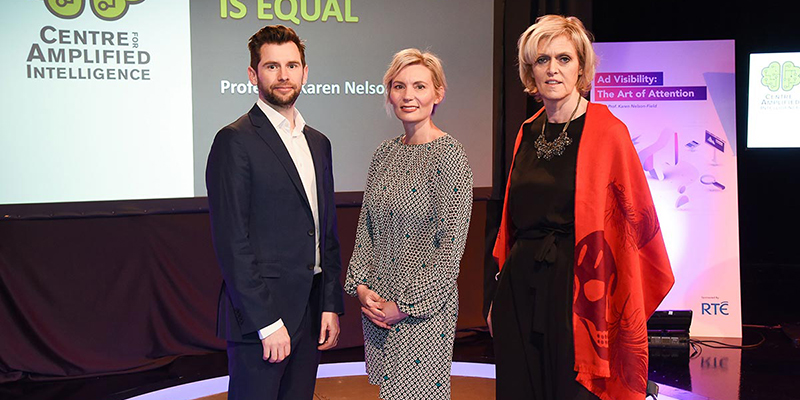
RTÉ was honoured to host the Marketing Society and guest speaker Professor Karen Nelson-Field to speak about The Art of Attention.
Karen Nelson-Field is Founder and Executive Director of the Centre for Amplified Intelligence, research consultancy group made up of PhD trained marketing researchers and computer science engineers. They apply the power of human intelligence in research design and amplify it with technology. She has a PhD in media science and is a global authority in media strategy. She is also a Professor of Media Innovation at the University of Adelaide. Karen has held executive roles in media, tourism and FMCG and worked at the Ehrenberg-Bass Institute for 10 years, before going into business for herself.
We were joined by 120 leaders of the marketing industry for Professor Nelson-Field’s presentation on the topic “Not All Reach is Equal”. You can see the full presentation below.
This proved to be a highly informative and enjoyable session where Professor Nelson-Field shared the results of her two-year cross-platform research project, The Benchmark Series, and pointed out the media attributes that really matter for brand growth.
This presentation opened on the premise that the pendulum of advertising spending has swung towards digital and that Professor Nelson-Field and her team were approached to “Re-Establish the Media Baseline”. As a professor of a renowned university she ensured that the research was carried out on her terms and that the results were the results, and there would be no thumb on the scale to favour any media.
Cut-Through and Memorability
In phase 1 of the research they tested Cut-Through via Attention and Memorability via product choice. Attention was measured by “gaze-tracking”. Amplified Intelligence built an app which a panel member downloaded, the app engages the camera to track eye-movements and intercepts ad load to ensure that the same creative was seen on all platforms. In 5,000 viewer sessions there were more than 50,000 test ad exposures. This was done on laptop for YouTube and Facebook and using a phone camera to track TV. The panel were then sent to a discrete choice store, which is the gold standard for measuring choice.
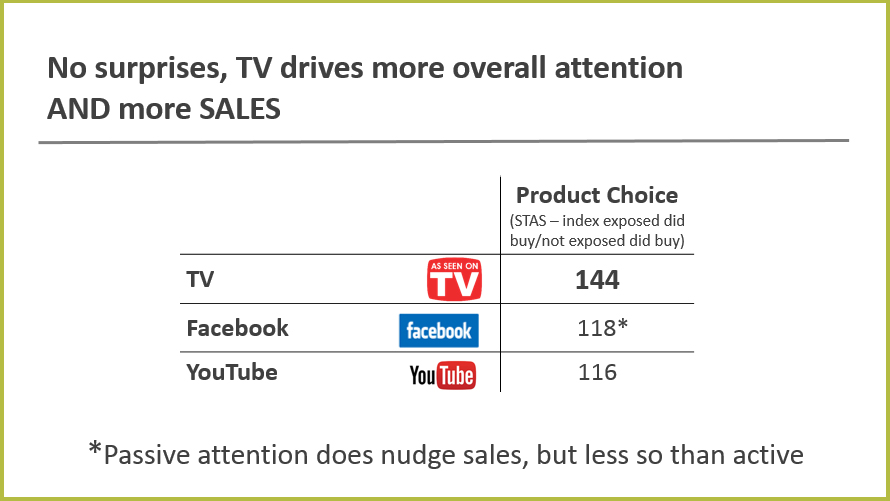
The results of the first phase were pretty clear. TV get’s twice the active viewing as YouTube and fifteen times that of Facebook. She also mentioned that passive viewing, plays a role but not as much as active. What they found was that attention and product choice are related, and that was consistent across all data sets (8). As a result of TV driving more overall attention, TV advertising drives more sales.
Mobile
In phase 2 of the research they measured the effect of mobile as many claim that mobile is the optimal platform for Facebook and YouTube. In order to maintain a standard across all platforms, they also tested TV on mobile. They used the same creative as in the previous phase, these were taken from a wide range of categories.
The device did make a difference. The Short-Term Advertising Strength (STAS) showed that small screens deliver more sales for all platforms, including TV. On all platform’s TV content outperforms the best of the online competitors.
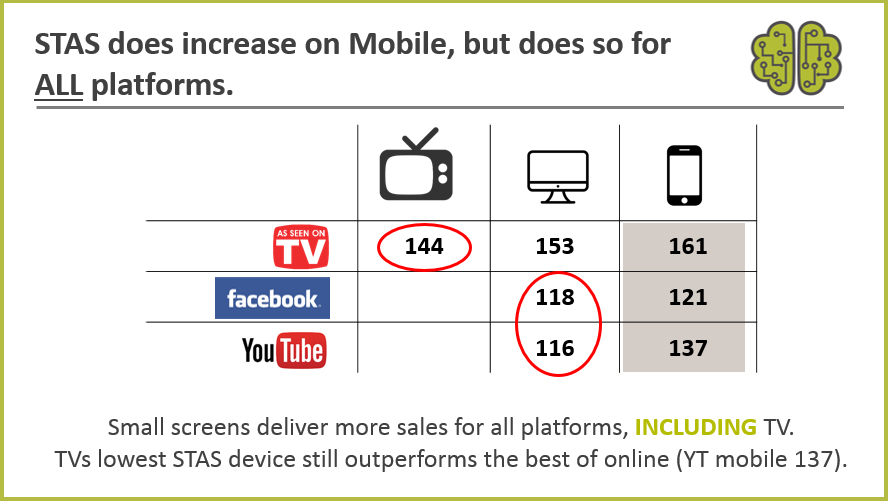
Coverage
The third phase looked at coverage and its effect on attention. As Professor Nelson-Field outlined, “coverage is an artifact of clutter, so the bigger the ad on screen the fewer ads that can sneak around the edge”.
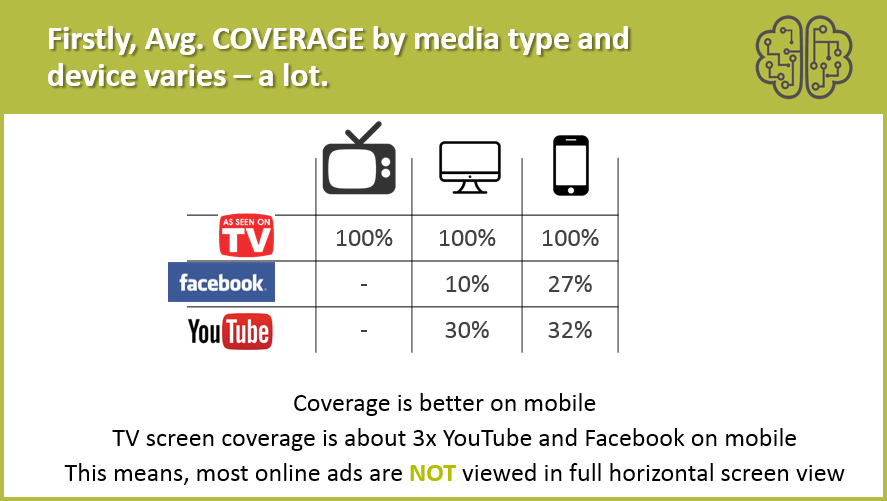
The majority of ads on Facebook are not viewed in full horizontal view despite what they claim. As a result, ad real estate differs significantly by device. And furthermore, coverage matters to attention and sales. As coverage is so vital, the current viewability standard (50% pixels and 2 continuous seconds of time) could be fostering underperformance in online. Coverage is different to pixels, but pixels vary a lot across device as well.
Karen and her team have found that the greater amount of pixels on screen the greater sales uplift and the longer period that the ad is on screen for has a huge effect. While this may seem obvious, the digital giants have been claiming that shorter ads have can have a similar impact which Amplified Intelligence have tested and proven to be false. Even at 100% pixels coverage has becomes more important. 100% pixels playing full screen, has a greater impact than 100% pixels covering a smaller proportion of the screen.

Long-Term Memory
In the next phase of the research, Professor Nelson-Field's team examined the phenomenon of decay. Following the work of the previous studies they asked six groups to return to the store after 14 days and then 28 days without seeing the creative again. In doing this they were able to work out which platform offers advertisers the slowest rate of decay. What they found was that Facebook decayed 2.5x as fast as TV and YouTube decayed 3x as fast as TV.
The most interesting number that they found was that an ad seen on a TV screen it takes 109 days for it to no longer have an impact, 101 days longer than it takes its competitors on mobile. The double jeopardy in decay: Overall TV gains in two ways, it starts from a higher STAS and it decays more slowly.
Multi-Platform
For the most recent phase of the Benchmark series, the study looked at multi-platform buying. The findings show that if an individual is going to look at a multi-platform buy, the combination of TV and Broadcaster VOD (BVOD) works better than a second view on the other platforms. According to the research conducted by Professor Nelson-Field, the other platforms could drag down the STAS achieved by a single exposure to TV.
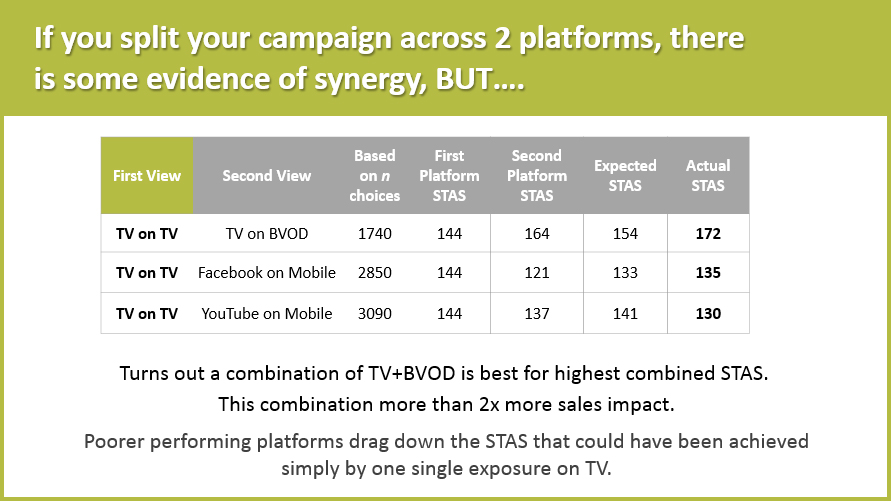
The lesson that we’re asked to take from this is stick to the highest performing platform for all reach points. The findings here support from the findings of the research completed by NeuroInsights for RTÉ which showed, among other things, that ads shown on RTÉ Player outperformed Facebook by 31% using the memory-encoding metric measured by the NeuroInsights team. RTÉ also performed much better than its competitors across TV and Radio with 11% and 24% higher memory-encoding respectively than its competitors.
To read more about this research click here.